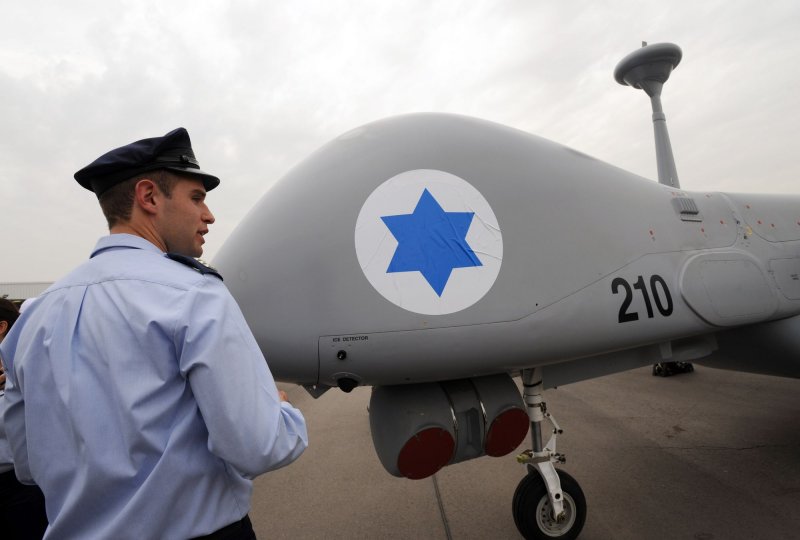An Israeli Air Force soldier looks at an Israeli made unmanned aerial vehicle, the Heron TP. The large drone is built by the Israel Aerospace Industries, IAI, and is capable of flying to Iran. It has a wingspan of 86 feet, the size of a passenger jet and can fly 20 consecutive hours. The drone is primarily used for surveillance and carrying payloads. UPI/Debbie Hill |
License Photo
TEL AVIV, Israel, Aug. 10 (UPI) -- Israel's air force has deployed aerial drones to keep watch on the country's disputed offshore gas fields in the eastern Mediterranean after Hezbollah threatened to target Israel's energy facilities if it tried to "steal Lebanon's resources from Lebanese waters."
The Israeli military drew up a plan to protect the fields, which contain an estimated 26 trillion cubic feet of natural gas, some time ago as Beirut's claims that Israel was intruding into Lebanese waters grew more threatening.
But the July 26 warning by Hezbollah Secretary-General Hassan Nasrallah prompted the Israelis to order the air force's Heron unmanned aerial vehicles to maintain round-the-clock surveillance against a range of possible attacks by missiles, aerial bombs, airborne and ship-borne suicide bombs, torpedoes and airstrikes.
The Heron, developed and built by Israel Aerospace Industries, is equipped with special electro-optical systems for maritime operations. It isn't clear whether the Israelis are using armed UAVs for the operations.
"Israel's concern is that Hezbollah will try to attack the Israeli gas rigs at sea in explosive-laden ships or with anti-ship missiles," Yaakov Katz, The Jerusalem Post's military analyst, reported Wednesday.
The primary targets would likely be the Leviathan field 81 miles west of Haifa, which contains at least 16 trillion cubic feet of gas, and the nearby Tamar field, 30 miles west of Haifa, which holds around 8 tcf.
These could make energy-short Israel self-sufficient for decades, saving $4 billion in imports annually, and even transform it into a gas exporter.
That makes the gas fields holding reserves estimated to be worth $40 billion, of immeasurable strategic importance to the Jewish state, particularly if neighboring Egypt, which has supplied Israel with gas in the past, seeks to distance itself from its 1979 peace treaty following the fall of President Hosni Mubarak in February.
The Israeli navy's chief of intelligence, Brig. Gen. Yaron Levi, observed last week that Hezbollah and the Palestinian Hamas movement in the Gaza Strip, both armed by Iran and Syria, have obtained advanced missiles capable of hitting anywhere in Israel, including the offshore gas fields and onshore facilities and ports.
"The challenges facing the navy are many, from the Gaza Strip to the north," Levi noted during a conference in Tel Aviv.
"Iran is overseeing everything from above. Iran is the dominant element with regard to funding and transferring weapons to our neighbors."
Hezbollah, in particular, is known to operate C-802 anti-ship missiles, designed by the Chinese but upgraded by the Iranians, and first used them in combat on July 14, 2006, during the opening phase of the 34-day Israel-Hezbollah war in July and August that year.
The Shiite group, Hezbollah, reportedly using radar data provided by sympathizers in the Lebanese army, badly damaged an Israeli corvette, the Hanit, 10 miles off the Lebanese coast with a C-802.
It carries a warhead packing a shaped charge of 390 pounds of high explosives. Israeli defense analyst David Eshel says that's "a most capable threat to major warships, including U.S. aircraft carriers."
In the same attack, another C-802 sank an Egyptian freighter passing 40 miles out to sea. The missiles have a range of around 25 miles, so for an attack on offshore drilling platforms they would have to be fired from a ship.
"We're aware of the anti-ship missiles that are possesses by terrorist organizations and are preparing accordingly," Levi said.
Hezbollah also has an unknown number of Iranian-produced UAVs, the Ababil and the older twin-tailed Mirsad. These supposedly could be loaded with explosives and used as flying bombs.
The group's first UAV mission over Israel, a test surveillance flight Nov. 7, 2004, was with a Mirsad that crashed into the sea off the coastal town of Nahariya -- the general area where the gas fields are located.
Hezbollah launched two Ababils against Israel Aug. 13, 2006, in the closing hours of the war. Both were shot down.
Nasrallah claimed in April 2005 that the UAVs, with a maximum range of 150 miles, could be packed with 88-110 pounds of explosives to attack "priority targets deep inside Israel."
Leviathan and Tamar would be key targets. But onshore facilities, such as gas storage tanks around Haifa, processing plants, export terminals and pipelines would also be exposed to attack by Hezbollah.





